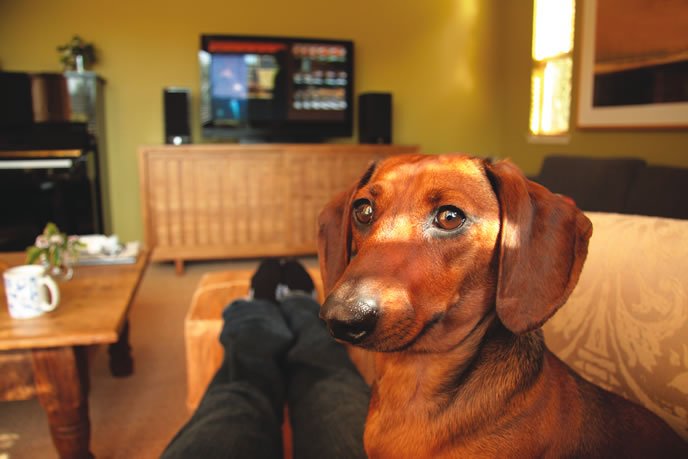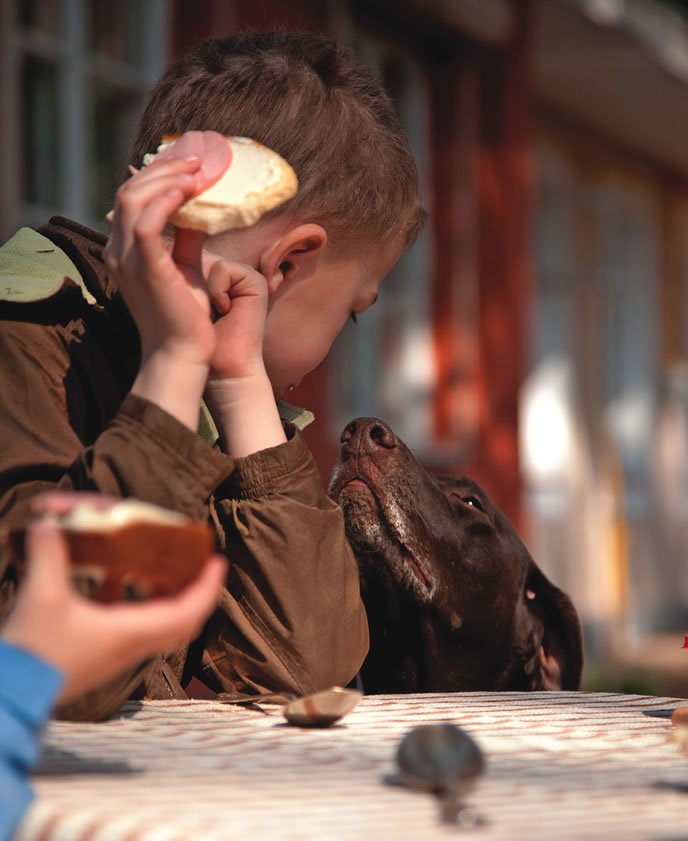[Updated December 14, 2018]
I can’t tell you how many times someone has said to me, “I don’t give my dog ‘people food’ because I don’t want him begging at the table while we’re eating.” If this sounds like you, I’ve got good news for you, and maybe even better news for your dog!
Many people avoid offering their dog any type of food that they themselves might eat for fear that the dog will acquire a taste for it and develop an annoying and invasive habit of begging for food during family mealtimes.
While preventing “begging” is a good goal, it can be achieved no matter what you feed your dog. The type of food isn’t what will determine whether or not your dog will learn to beg at the table. Rather, his behavior will be shaped by where, when, and how he gets access to food. Luckily, this is entirely under your control.
How Your Dog’s Behavior is Built
To get a clear picture of how begging inappropriately for food can develop, let’s start from the beginning. We know that food can be an excellent reinforcer for a dog. Delivering food as a reward immediately following a behavior is likely to produce more of that behavior.
When you are sitting at the table to eat your meal, if your dog nudges your elbow, stares you down, barks, whines, licks his lips, or paws your leg, and immediately gets access to something yummy, he learns that this is an effective strategy to get food, and a beggar is born.
The same principle applies to dogs who hang around the kitchen while meals are being prepared and who are occasionally rewarded with tidbits of food. Their access to food in the kitchen might be intentional – like when the household chef shares a few ingredients with the dog who expertly offers a sad face – or it might be the result of simply acting fast enough to swoop in and gobble up food that is accidentally dropped to the floor from the counter. Regardless of how or why the dog has access to food, the bottom line is that the kitchen area has become very attractive (and reinforcing!) to him, and is now a location where he is likely to hang out in the presence of food.
© Cathysbelleimage | Dreamstime.com

It’s the fact that there was a reinforcement (rather than the specific type of food) that creates and maintains this behavior; understanding this is key to figuring out how to prevent it from developing in the first place, and how to change it if it already exists.
While not all of our foods are appropriate for dogs to eat, many of the foods we eat are just as suitable for dogs as they are for us. For those of you who do want to share some of your food with your dog, but choose not to for fear of creating a beggar, rest assured that there is a way to teach your dog good table and kitchen manners and allow him to enjoy some of the same foods as you. Those who prefer not to share “people food” with their dogs can just as effectively teach them polite manners around the dining room table and in the kitchen.
Nothing to See Here, Now Move Along
Remember the old joke that describes a patient complaining to his doctor about pain in his elbow when he bends his arm, only to be told by the doctor, “Then don’t bend your arm”? The same sort of logic can be applied here. If you don’t want your dog begging for food at the table, don’t ever feed him at the table. If you don’t want your dog begging for food at the kitchen counter, don’t ever feed him at the kitchen counter.
Management plays a crucial role in helping your dog figure out that there is no benefit to hanging around the table or kitchen. (If your dog has a history of stealing food off the table or kitchen counter, avoid leaving food unsupervised in these places at all times!) Set up the environment to make it easy for your dog to behave well, and to make it difficult – or impossible – for him to make a mistake. Make sure everyone in the family is on the same page regarding your dog’s access to food: No food delivered at the table means no food delivered at the table, from anyone.
You may want to feed your dog his meal before you sit down to eat. He won’t be as hungry, and therefore not as interested in the food on your plate as he might be, on an empty stomach.
Alternately, feed him at the same time as yourself. If his mealtime doesn’t coincide with your own, arrange for your dog to have somewhere to go, like a crate or a cushion, where he can get busy working on a bone or an interactive food toy filled with a light snack while you sit down to eat. Add an indoor tether if your dog has trouble staying put on his cushion and keeps coming back to you at the table. An indoor tether is an excellent management tool for young dogs, especially as they learn your household rules.
© Julia Krapotkina | Dreamstime.com

Even Sharing is Okay
I mentioned earlier that it is possible to share your food with your dog, without creating a beggar at the table. I love to give pieces of various foods to my dog while I cook, and even while I eat. I simply deliver the food to her in a way that encourages her to stay far away from me while I cook or eat.
For example, while I work at the kitchen counter, I might look at my dog and show her a piece of whatever vegetable I’m chopping. She responds by sitting in the adjoined dining room, where I toss her the veggie bit. Through repetition, she has learned that the only way she’ll get food from the kitchen is if she sits 10 feet away in the dining room. That is where the food is delivered whenever I’m working in the kitchen.
If I’m sitting at the dining room table and want to share a piece of food from my plate with her, I’ll toss it a few feet away, into the living room. My dog has learned that her chances of receiving food while we eat at the table are increased if she sits far away, in the living room. She has never received food while sitting next to us at the table, and therefore has no history of ever being reinforced for this behavior. If she lurks close to the table, she may be ignored or she might receive a pat, but she will never receive food.
The same rules apply when we are eating food in the living room. There is a very good chance that snacks during movie time will be shared, but only if my dog moves into the dining room a few feet away. Because of our reinforcement history, and where and how food is typically delivered, my dog can snuggle peacefully next to me while I eat a snack on the couch, and if she is offered a piece of food – a bite of apple or a chunk of watermelon, for example – she will rise and head for the dining room, where I’ll gladly toss her a few pieces.
Just Once?
Keep in mind that your dog will not differentiate between official household rules and those “okay-then-just-this-one-special-time” occasions. If every member of your family adheres to the general rules, your dog will have an easier time understanding what is expected of him. Establish the rules and stick to them. As a guideline:
1. If you don’t want your dog to eat “people food,” don’t give him any. Ever. (Although it really is quite alright to do so, barring any dietary restrictions for medical reasons.)
2. If you don’t want your dog begging for food at the table, don’t give him any food while he is next to the table. Ever. Not even his own food.
3. If you don’t want your dog in the kitchen area while you cook, don’t give him food while he’s in the kitchen. Decide where you want your dog to be instead, and reward him for being in that spot (whether you choose to reward him using his own food or “people food”).
4. Decide where you want your dog to be while you eat. Make that area a great place for him to be by giving him something enjoyable to do while you eat. Manage his mobility while he learns this new rule by using a crate, tether, baby gate, or closed door to restrict his access to the table.
5. If you do want to share your food, decide where you want your dog to be while you eat, and deliver the food in that place. If you catch your dog spontaneously going to that place while you eat (without your having asked), go ahead and reinforce this by going to him and rewarding him, or by tossing some food to him.
It’s okay if the food is tossed from the table or the kitchen counter, as long as your dog is already where you want him to be before you toss the food. In other words, food being tossed to your dog is conditional on him being in a certain location. If your dog is already begging at the table, don’t toss the food in order to get him to move away from the table, as that would actually be reinforcing the wrong behavior.
Remember, you will get whatever you reinforce. As with all behaviors, decide what you want the dog to do, set things up to make it easy for your dog to choose that particular behavior, and then reinforce it!
Nancy Tucker, CPDT-KA, is a full-time trainer, behavior consultant, and seminar presenter in Quebec, Canada. She has written numerous articles on dog behavior for Quebec publications focusing on life with the imperfect family dog.





